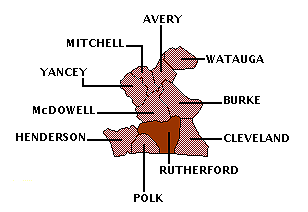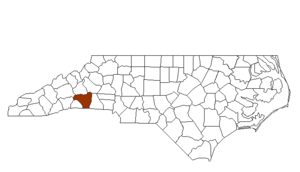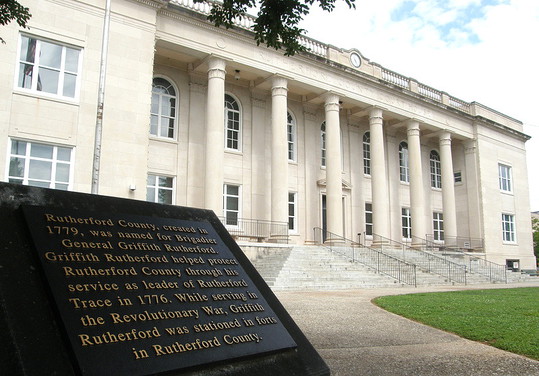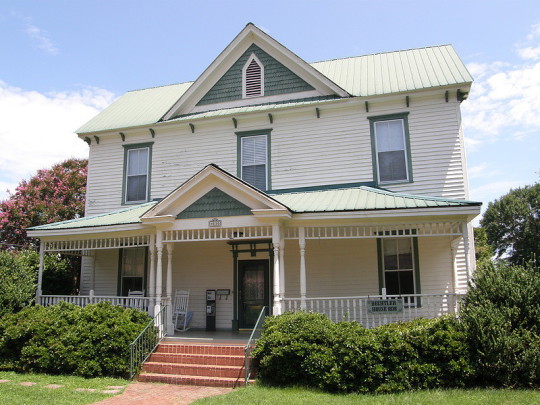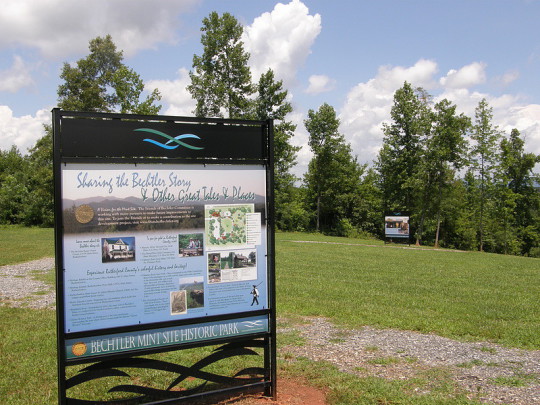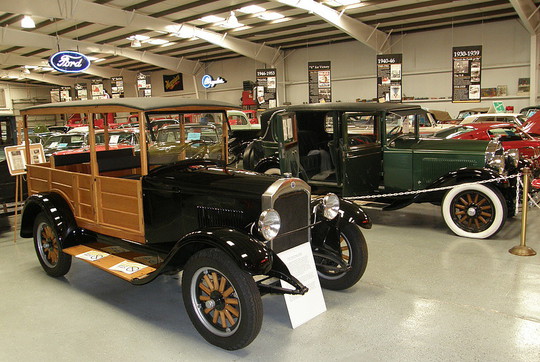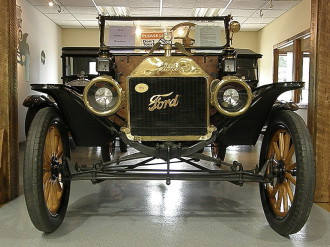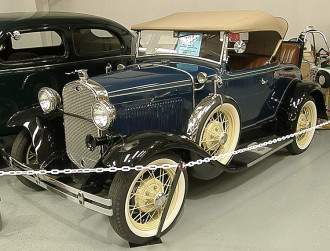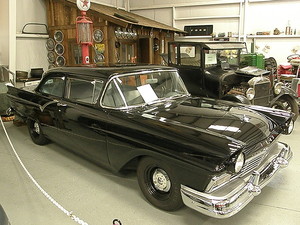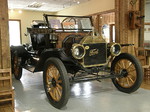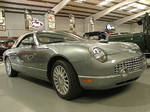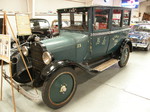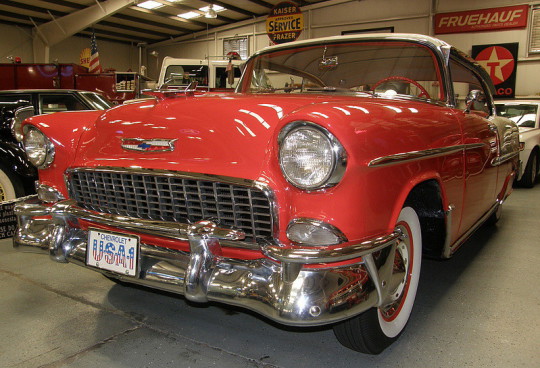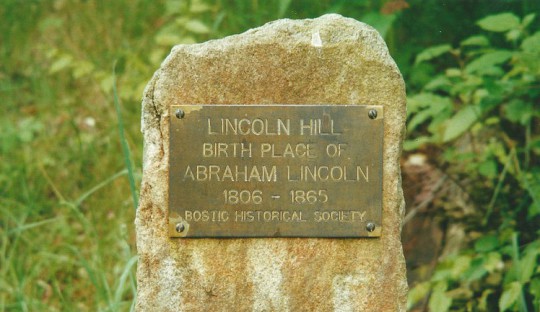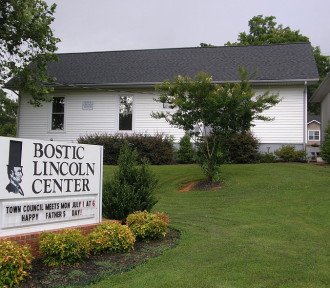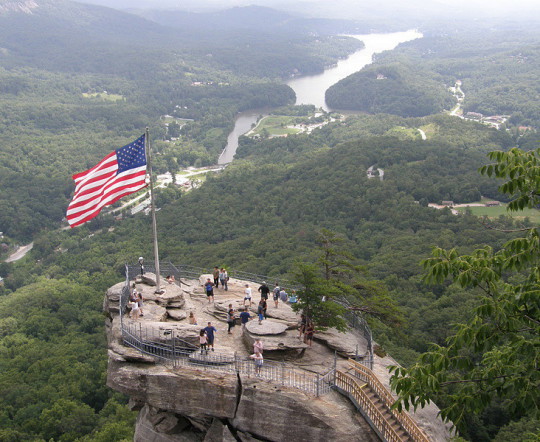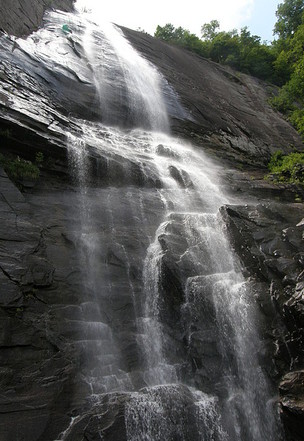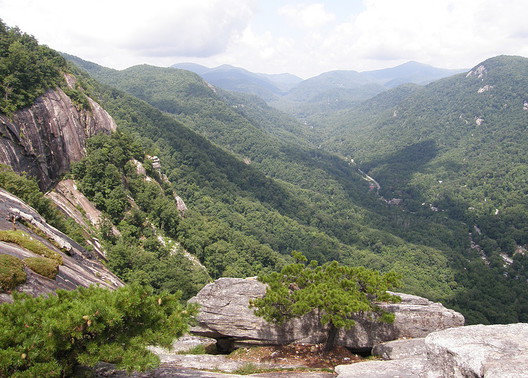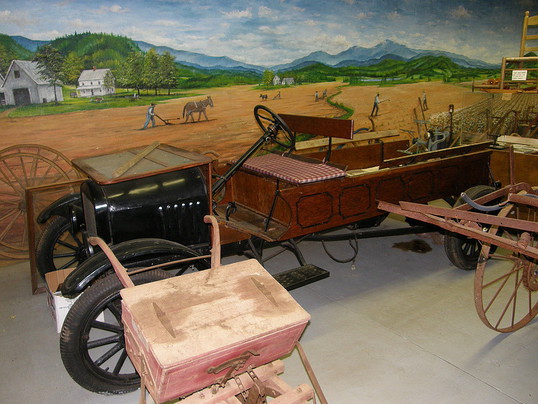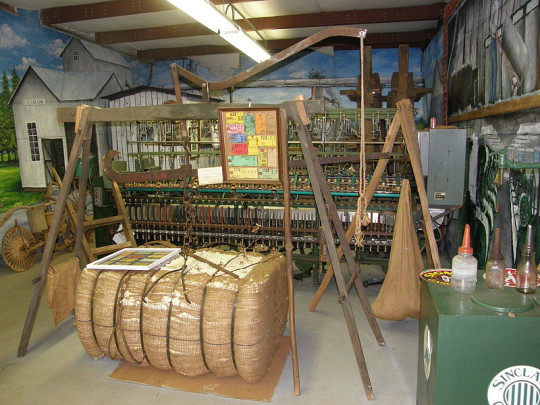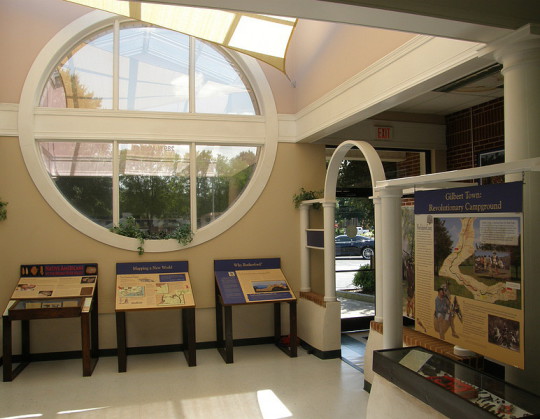RUTHERFORD COUNTY
Scroll down this page or click on specific site name to view features on the following Rutherford County attractions/points of interest:
Bechtler House, Bennett Classics Auto Museum, Bostic Lincoln Center, Chimney Rock State Park, Rutherford County Farm Museum, Rutherford County Heritage Center
Fast facts about Rutherford County:
Created in 1779, the county is named for Revolutionary War General Griffith Rutherford.
The county seat is Rutherfordton. Other communities include Bostic, Chimney Rock, Ellenboro, Forest City, Harris, Spindale, and Sunshine.
Rutherford County’s land area is 564.12 square miles; the population in the 2010 census was 67,810.
It is worth noting that many people believe that US President Abraham Lincoln was born in Rutherford County, North Carolina, rather than in Kentucky.
Below: Rutherford County Courthouse, Rutherfordton
Rutherfordton
The Bechtler House helps preserve the legacy of Christopher Bechtler [pronounced Beckler], a German immigrant who operated a private mint in Rutherford County at the height of the North Carolina gold rush. In addition to producing $2.50 and $5.00 coins, Bechtler minted the very first $1.00 gold coins in America, 17 years before the United States Mint began producing them.
Bechtler migrated to America in 1829, along with his two sons, Augustus and Charles, and a nephew, John Christoph. After residing briefly in Philadelphia, Bechtler and his sons, along with John Christoph's older brother Carl, moved to Rutherford County. At the time of their arrival in 1830, the nation’s principle supply of gold came from Rutherford, Rowan, Cabarrus, and Mecklenburg counties. After opening a jewelry business, Bechtler began mining operations on his own. He was soon convinced by US Congressman Samuel Carson that his talents and expertise as a jeweler could be put to better use by opening a much-needed mint, where local gold could be converted into coin, rather than being shipped to Philadelphia for minting. Bechtler did so, quickly establishing for himself a reputation as an honest man who produced coins equal to or superior in quality to those made in Philadelphia. The Bechtler mint stamped between 2.25 and 2.5 million dollars in gold coins during its two decades of operation. The fee for converting gold into coins was $2.50 for every $100 minted. The establishment of a United States Mint in Charlotte in 1837, combined with an ever-decreasing amount of locally-mined gold during the 1840s, finally led to the closing of the Rutherford mint. By that time, Christopher Bechtler and both his sons had already died. Ironically, Bechtler’s death was directly attributable to his working with the harmful agents used in the process of refining gold.
The Bechtler House, built for Christopher in 1838, started as a two-story house with one room on each side of the central hallway on both floors. It has been converted into a "heritage center," with the single most significant artifact being the actual press used to stamp America’s first one dollar gold coin. Appopriately, one representative coin of each of the three denominations Bechtler minted are also on display. Another noteworthy artifact is Augustus Bechtler's 50-caliber double barrel rifle, inscribed "A. Bechtler" and "N Carolina" in gold inlay. The house is open Fridays from 10 AM to 1 PM and Saturdays from 10 AM to 3 PM. The house is open Monday through Thursday by appointment. Admission is free. 828-286-9977
Located approximately three miles north of Rutherfordton, on Gilboa Church Road, is the Bechtler Mint Site Historic Park. Although no historic buildings remain, the park has several informative display panels on the landscaped grounds, inlcluding an interactive exhibit entitled "Hidden Floor of Gold," which demonstrates Bechtler's method of capturing and retaining gold dust often lost in the assaying process. The park may also include the location of the Bechtler mine.
The Bechtler House is also "home base" for the developing NC Gold Trail. See www.visitncgold.org for additional information regarding the Trail.
Forest City
One need hardly be a car enthusiast to enjoy a stroll down memory lane at the Bennett Classics Antique Auto Museum in Forest City. The 20,000-square-foot facility exhibits about 70 vintage automobiles at any given time, from some of the earliest Model T’s all the way through the late 1970s. Complimenting the impressive collection of cars is a small assortment of trucks, tractors, and motorcycles. The Museum showcases the collection of brothers Buddy and Joe Bennett, who came by their love of automobiles quite naturally – their uncle, Joe Young, opened a Ford dealership in Burnsville, NC, in 1920. By the time they seriously began collecting cars in the early 70s, the brothers had already moved to Forest City. In May, 2007, they opened the doors to the Museum, and the facility has steadily grown in popularity for the best of reasons – it spotlights some of the best and most beloved cars ever to roll off Detroit’s assembly lines.
Speaking of Ford’s revolutionary assembly line, the museum features a 1913 Model T Ford Roadster, one of the cars which came off the line the first year it was introduced. The roadster has carbide headlights, oil lanterns, and a hand crank. When it debuted in 1908, the Model T cost $825. Thanks to Ford’s constant striving to improve efficiencies and trim costs, the price came down steadily over the years, making the product increasingly affordable for the average American family. By the late 1920s, a new Ford could be purchased for under $400. The father of the assembly line had some pretty straight-forward terms for his early buyers. “Any customer,” said Ford, “can have a car painted in any color that he wants, so long as it’s black.” Another of his business axioms was “Our terms are simple; 100% down, no monthly payments.” Ford relented on both points in the 1930s.
Many other vintage Fords are displayed, including a classy 1931, Washington-blue Model A Roadster with a leather rumble seat; a 1939 Deluxe all-weather convertible sedan; a 1957, jet-black sedan nicknamed the “Shine Hauler” by the Museum staff because it was a popular choice of vehicles among moonshine runners; and a 1957 Thunderbird, one of the most recognizable sports cars of the late 1950s and owned by Uncle Joe himself, has only 28,000 miles on it and is in pristine condition.
General Motors fans need not worry. The Museum displays many classic automobiles sporting spiffy bow ties, especially those from the 1950s, when chrome was king. Side by side in a prime location, befitting the place they hold in American pop culture, are 1955 and 1957 candy-apple red Chevy Bel-Airs. Also on hand is the model that was one of the most desirable cars among college-age kids in the late 1960s – a Z-28 Chevy Camaro. Another “muscle car” popularized in song a few years earlier is the 1964 Pontiac GTO; the one on display is baby blue and sold new for $3,836. A nod is given to cars with foreign nameplates, including a 1951 MG and a 1970 Volkswagen Beetle, as well as to the modest American economy car of the early 1960s, the Rambler. Made by American Motors in 1962, the “deluxe” 4-door Rambler had a sticker price of only $1,846. The automobiles are arranged in a spacious, well-lit facility, many accompanied by period props; one that seems especially appropriate is the drive-in movie speaker attached to the passenger side window of a 1957 Ford Fairlane. For the most part, the cars are largely unrestored and sport original equipment. From downtown Forest City, turn right on Church Street, left on Main Street, and right on Vance Street. Entrance for the Museum will be about one block on the left. Hours are 10-5 M-S. Admission charged. 828.247-1767
Bostic
History books tell us that Abraham Lincoln was born in Kentucky in 1809, but you’ll hear a different story at the Bostic Lincoln Center. For generations, going back to when Lincoln was serving as the nation’s 16th president, many folks in and around western North Carolina, and Rutherford County in particular, have claimed that Lincoln was born three years earlier, in 1806, in a log cabin – no longer standing – near Puzzle Creek, close to present-day Bostic. Although the cabin is long gone, the stone foundations and cellar remain and the “Lincoln Hill” site can be visited by appointment. In Bostic, the repurposed train depot now houses The Bostic Lincoln Center, where visitors can learn details about Lincoln's possible Tar Heel origin.
While the story of Lincoln’s North Carolina birth may certainly be questioned, it is a well-established fact that Abraham’s mother, Nancy Hanks, lived in Rutherford County while “bound out” as a servant to the relatively well-to-do Abraham Enloe family. Between documented and circumstantial evidence and the oral histories of friends and neighbors who knew Nancy Hanks while she lived in Rutherford County, a compelling case can be made that Abraham Lincoln was indeed born to the unwed young girl in 1806, with at least two men mentioned as the child’s possible father – Abraham Enloe and John C. Calhoun. Spend some time at the Bostic Lincoln Center and decide for yourself what to make of the evidence. Hours are 1-4 on Thursday and 10-1 on Friday and Saturday. Admission is free. 828-245-9800
Chimney Rock
Promotional material for Chimney Rock State Park boasts, “In one place, the best of the mountains” and it’s hard to argue with the claim. Within the park’s 1,000 acres are hiking trails for all ages, eye-popping vistas, the majestic 404-foot Hickory Nut Falls, a moonshiner’s cave, a nature center and native plant nursery, and, of course, the grand 315-foot monolith that gives the park its name – The Chimney. It will take a full day to take advantage of all that the park has to offer.
The rock has been a tourist destination for nearly 130 years. Around 1870, Jerome B. Freeman bought a 400-acre tract which included the monolith from a speculation company for $25.00. Blazing a trail to the base of the rock and erecting a stairway to its summit, Freeman opened Chimney Rock to the public in 1885. In 1902, Dr. Lucius Morse, with the financial support of two older brothers, paid Freeman $5,000 for 64 acres of Chimney Rock Mountain. Over time, the brothers developed the site as a true tourist destination, building such improvements as a bridge over the Rocky Broad River, a stone gateway, a 470-step stairway from the monolith’s base to its summit, and blazing the Cliff Trail leading to Hickory Nut Falls. In 1946, plans were drafted to provide visitors to the Chimney with an alternative means to getting to the top – an elevator. It took eight tons of dynamite and eighteen months of labor to carve a 198-foot tunnel and a 258-foot elevator shaft out of the granite cliff, but perseverance paid off. In 1949, visitors were being whisked to the summit in less than a minute. The Sky Lounge, a café with views of both Chimney Rock and Lake Lure, soon followed.
Today the park features six trails, including the Skyline-Cliff Trail Loop, an invigorating walk that, until recently, took visitors to Hickory Nut Falls. There are many worthwhile stops along the way, among them Devil’s Head, the Opera Box, Exclamation Point (at 2,480 feet, the highest elevation in the park), and Peregrine’s Rest, which offers the first full view of the falls. For safety reasons, this trail currently stops short of the falls, ending at this overlook. The ¾- mile Hickory Nut Falls Trail originates at the parking lot and leads to the base of the falls. The Great Woodlands Adventure Trail, designed with kids in mind, is an easy .6 mile jaunt along a winding path. A 32-foot climbing tower is located next to the trailhead. Chimney Rock was privately owned until recently, when the state acquired the property and added it to an impressive list of state parks. It is open year-round, weather permitting, except for Thanksgiving, Christmas, and New Year’s Day. The park opens at 8 AM year-round; closing hours vary seasonally. Admission charged.
Forest City
Retired Navy Captain Wilber Burgin opened the doors to the Rutherford County Farm Museum in Forest City in 1994. Supplementing his own sizeable collection with items donated or loaned from local residents, Burgin attempted to capture a sense of the county’s past, especially its century-long economic dependence upon the textile industry. Said Burgin, “Time was, if you lived in Rutherford County you either worked on the farm or worked in the factory.” The evidence to support this statement is found in abundance in the Farm Museum, which occupies a building that was once a hardware store, and before that a lumber store. Don’t let the Museum’s plain exterior fool you – there’s a lot to see on the inside. Too much, perhaps, because the main room is crowded with so many farming implements that many cannot be showcased to their best advantage.
To a casual visitor, a collection of farm equipment would probably seem incomplete without a John Deere tractor. The Museum has one from the mid-1950s, painted in its signature bright green. Next to it, however, is a tractor not often seen, a 4-cylinder, 20 HP Fordson, circa 1919. Built by Henry Ford, it was the first efficient, economical tractor built in America. It cost $200 and had interchangeable parts – in fact, Ford’s Model T automobile could be converted into a tractor because it used the same engine! Among other farm equipment on display is a hay rake, hay baler, corn planter, corn husker and shredder, and corn sheller. There’s also an Oliver plow – it took three mules to pull this plow, which would turn a furrow 16” wide and 9” deep.
The most impressive area in terms of display focuses on the textile industry, an economic lynchpin literally interwoven into the fabric of Rutherford County communities for a hundred years. One wall-length mural by local artist Clive Haynes depicts fields of cotton being planted and harvested. His mural on the opposite wall shows the county’s cotton mills. In the display area between them are a variety of farming and manufacturing equipment associated with either the raising of cotton of the production of cloth. From the 1940s is a cotton duster used to spread pesticides – including arsenic – to combat infestation by boll weevils. From the 1920s is a flatbed Ford truck with a hand crank on the front. In those days, customers would buy the chassis and custom build the truck body themselves to suit their needs.
At the back of the Museum are several small rooms displaying a hodge-podge of items, vestiges of days gone by. Among the hundreds of artifacts are a gas-powered Maytag washer, a 1902 Grafonola record player, and a Home Comfort stove with a porcelain front, considered the “Cadillac” of kitchen appliances. There is some interesting paper memorabilia as well, including a 1796 Rutherford County land grant signed by Governor Benjamin Williams, another land grant from 1856 bearing the signature of Governor Thomas Bragg, and an undated county bond intended to raise capital for the Wilmington, Charlotte, and Rutherford Railroad Company. In Forest City, turn onto South Powell Street, then onto Depot Street. The Museum is open 10-4 Wednesday-Saturday. Admission charged. The Museum is self-guided, but someone’s always on hand to provide information about the items on display.
Rutherfordton
The Rutherford County Heritage Center is located in the lobby area of the County Office Building at 289 North Main Street in Rutherfordton. Maximum use is made of minimal space, with highly informative display panels, accompanied with especially well-chosen artifacts, covering a wealth of county history, from the earliest Native American inhabitants and early colonial settlers to the region’s involvement in the Revolutionary and Civil Wars. Special attention is given to the gold mining industry during the 1830s and 1840s, and German immigrant Christopher Bechtler, who operated a private mint at the height of the North Carolina gold rush and produced the very first one dollar gold coin in America. Center hours are 8-5 Monday through Friday. Closed holidays. Admission is free.
The Rutherford Heritage and Visitor Center is located in the Town Hall building at 129 North Main Street. Display panels at this location focus on the architectural highlights of the town and county. Hours are 8-5 Monday through Friday.
Rutherford County is bordered by BUNCOMBE (Region Ten), BURKE, CLEVELAND, HENDERSON, McDOWELL, and POLK counties.
Return to REGION NINE HOME PAGE.
Return to GEOGRAPHIC REGIONS HOME PAGE.

